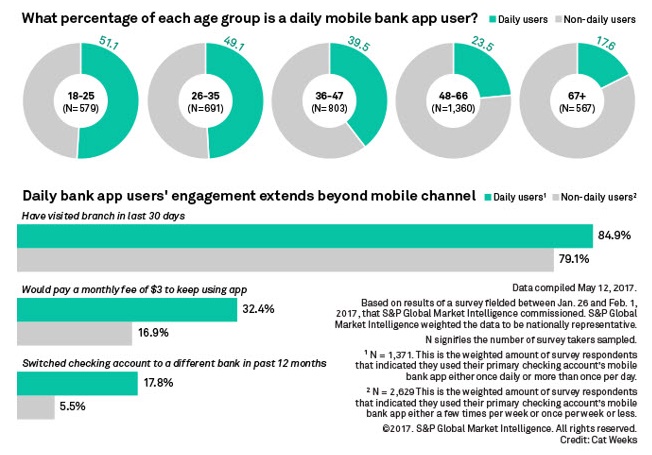Despite the growing popularity of banking apps, the death knell for brick-and-mortar branches should not be sounded just yet.
In the 2017 Mobile Money survey from S&P Global Market Intelligence, 81% of the mobile bank app users polled said they had visited a branch of their primary bank sometime within the month prior to taking the survey.
What is more, the study showed a higher percentage for those that used their app at least once a day. That is, customers that used their mobile app more were more likely to have visited a branch than those that used their app less than once a day. Based on this, perhaps apps can be viewed as a barometer for the most engaged customers, both in the cyber world and the real world.
But while they may still be going to branches, frequent app users are not necessarily loyal to their banks. The survey showed that daily app users were three times as likely as non-daily users to have switched their checking account to a different bank in the year prior to the survey. It might be that these frequent app users are hunting for the best possible terms and services, which could include the functionality of the bank’s app. Active users were much more willing to consider opening a checking or savings account with a “branchless bank” (i.e. one with no physical building/office locations).
Deposits and withdrawals were the most commonly cited activities that these so-called power users did inside their bank branch. The same was true for non-daily app users. One of the areas where the two groups notably diverged, however, was savings and investment services. Of daily app users that visited a bank branch in the prior month, roughly 17.7% made use of savings and investment services at the branch. For non-daily users, the percentage was only around 6.4%.
As one might expect, the people that used the app heavily were more open to the idea of a paid app. Daily users were nearly twice as willing as non-daily users to pay a fee of $3 per month to keep using their mobile bank app. The age breakdown of active versus non-active users was also as one might assume. About half of those aged 18 to 25 used their app at least daily, versus 17.6% of those aged 67 and over.In terms of the services they use on the app, daily and non-daily users do many of the same things, such as checking their balance and reviewing transactions. One of the areas where they seemed to differ, though, was transferring money to another person. About 25.7% of daily users said this was a feature they used most, versus around 12.2% for non-daily users.
As far as features they would like to see, daily users were much more likely to want a smartwatch app than non-daily users, which stands to reason. The daily users are likely more tech-savvy in general, and therefore probably want to use the latest technological gadgets.
The 2017 Mobile Money survey was fielded between January 26 and February 1 from a random sample of 4,000 U.S. mobile bank app users aged 18 and older. S&P Global Market Intelligence weighted the data to be nationally representative. Results from the survey, which was conducted online, have a margin of error of +/- 1.6% at the 95% confidence level based on the sample size of 4,000.

